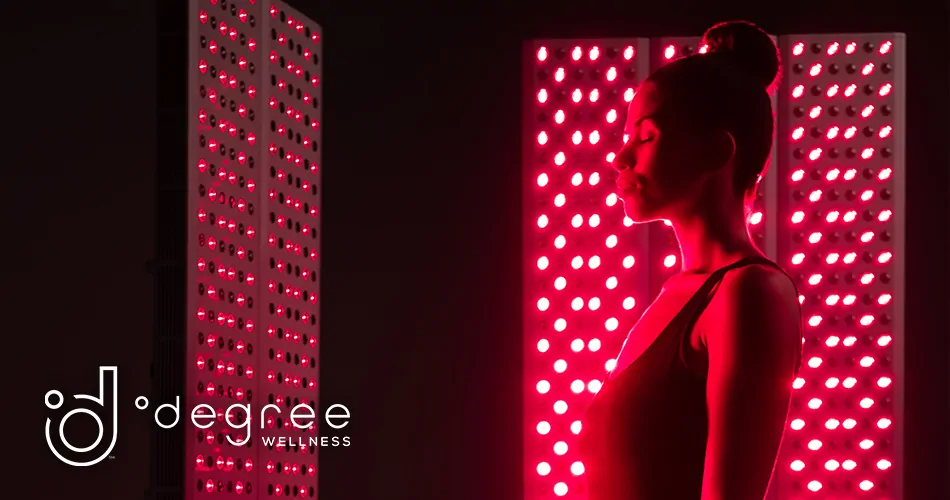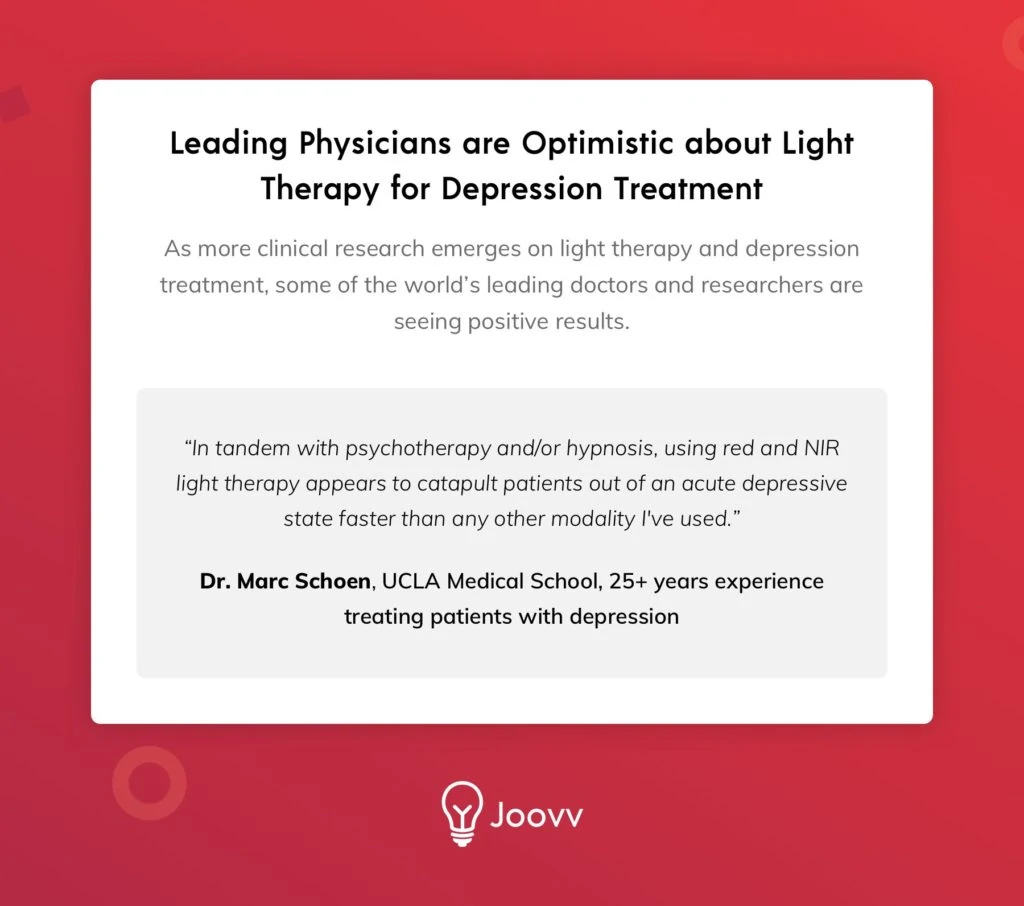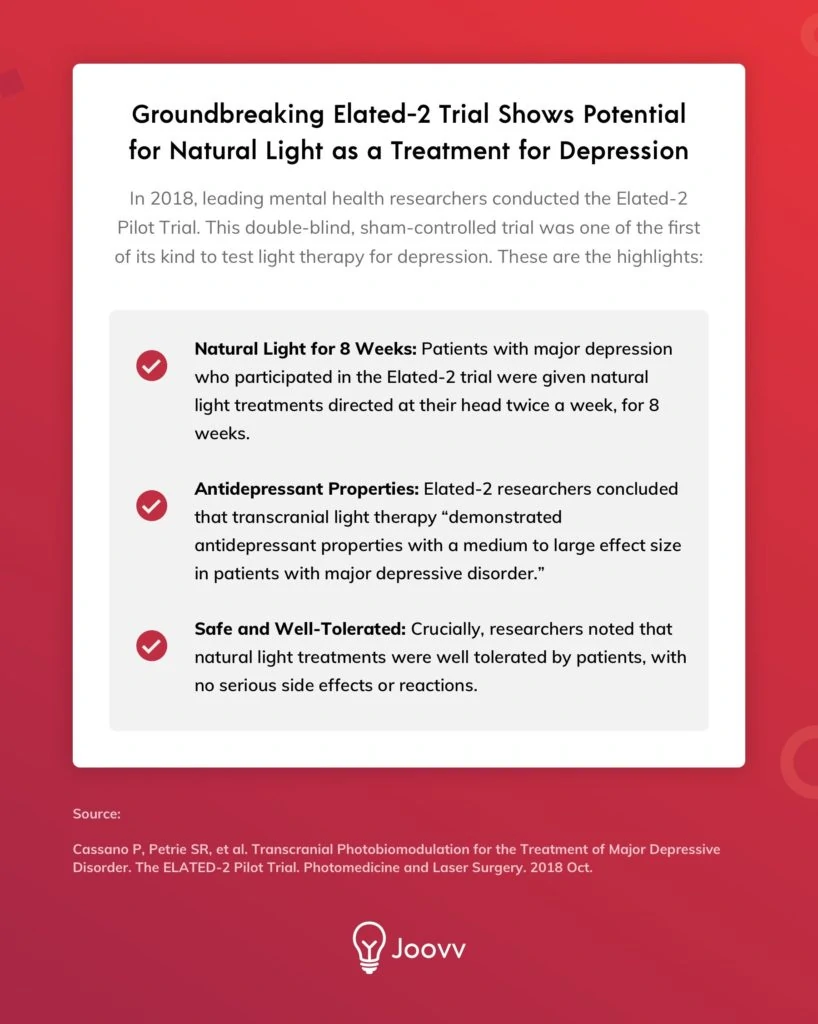Emerging clinical research is showing potential for red light therapy (PBM) to treat seasonal affective disorder (SAD) and other forms of major depression. This post examines this initial research and breaks down the connections between mood disorders, natural light intake, and sleep.
What is Seasonal Affective Disorder (SAD)?
Seasonal affective disorder (SAD) is classified as a type of major depression with a seasonal pattern. [1] SAD typically impacts people the most in the fall and winter months, when it’s colder and there’s less natural light. SAD affects millions, including at least 5% of adults in the United States. [1]
Current treatments for SAD are similar to treatments for other forms of clinical depression, including psychotherapy and antidepressant medications. Some people with SAD try lamps that shine bright artificial light, which is meant to mimic the sun and decrease darkness in the home and workplace. Emerging clinical research is also showing potential for treating SAD and depression with natural light treatments, like red and near infrared (NIR) light therapy.
This article provides an overview of the encouraging preliminary research that’s been conducted on light therapy as a treatment for depression, which could become another clinical tool that helps people overcome mental health challenges. This information is not meant to suggest replacing other, more established therapeutic interventions, and if you or a loved one struggles with depression, we suggest seeking guidance from a trusted medical provider.
Our Natural Light Problem
It can be very difficult to get enough natural sunlight in the winter months, when the days get shorter and darker. Plus, because of jobs and other daily commitments, the average American spends over 90% of their time indoors. [2] Many Americans, especially those in northern climates, are all too familiar with the demoralizing feeling of getting to work before the sun is up, putting in a full day on the job, and then going home after the sun has already set.
People who have not been diagnosed with a major depressive disorder can be negatively affected by a lack of natural light too. For example, lack of natural light exposure in the workplace has been shown to result in higher levels of cortisol and lower levels of nighttime melatonin, which are associated with depression symptoms and poor sleep quality. [3]
Bottom line: due to no fault of our own, it can be a major challenge to get enough natural light, especially in the winter, with negative consequences for health and well-being.
How Does a Light Therapy Treatment Work for Mental Health?
“Red light therapy”, otherwise known as photobiomodulation, is used to describe natural light treatments that most often include red and near infrared wavelengths. For mental health treatment, NIR wavelengths may be most effective in treating depression, because they can reach deeper into body tissues than red light. [4]
When NIR light from a clinical light therapy device is shined on a person’s head, those wavelengths are actually able to go beyond the surface of the skin and reach the brain and affect brain cells directly. Natural light is absorbed by the mitochondria, which boosts cerebral metabolism, improves neuroplasticity, and decreases inflammation, according to cutting-edge depression research. [5] More natural light for your brain cells has also been found to improve the metabolic capacity of your neurons, increase oxygen consumption, and boost cells’ ATP energy production. [6]
Leading Medical Professionals Believe Light Therapy Can Potentially Have a Big Impact on Depression Treatment
Dr. Michael Hamblin of Harvard Medical School is one of the world’s leading photomedicine researchers, and a member of Joovv’s Scientific Advisory Board. He believes that in addition to the brain, natural light is also absorbed “systematically through the skin,” resulting in increased circulation, which may positively impact the brain and mental health.
Dr. Marc Schoen of UCLA Medical School has 25+ years of experience treating psychological disorders. In the last few years, Dr. Schoen has found success treating patients’ acute, recurrent major depressive episodes with natural light treatments, in conjunction with medication and psychotherapy.
“In tandem with psychotherapy and/or hypnosis, using red and NIR light therapy appears to catapult patients out of an acute depressive state faster than any other modality I’ve used,” says Dr. Schoen.
Dr. Schoen has also observed that red and NIR light therapy speeds up the recovery process for patients with serious depression.
“Using pharmaceutical interventions, along with psychotherapy and/or hypnosis, for patients with acute, recurrent major depressive episodes requires extended periods of time for results to materialize,” says Dr. Schoen. “Adding red and NIR light therapy appears to significantly speed up the healing process.”
In the coming years, more and larger clinical studies will be required, but emerging research is already showing how natural light therapy’s effects on the brain can produce significant antidepressant and anti-anxiety effects that we’ll discuss below.
Emerging Clinical Research Shows Potential for Natural Light as a Safe, Effective Treatment for Depression
In 2018, leading mental health researchers conducted the Elated-2 Pilot Trial to test transcranial near infrared light therapy for people with major depression symptoms. This double-blind, sham-controlled trial was one of the first of its kind. Its positive findings have encouraged optimism about wider use of natural light treatments for people with depression. These are the highlights [5]:
- Natural Light Treatments for 8 Weeks: Patients with major depression who participated in the Elated-2 trial were given natural light treatments directed at their head twice a week, for 8 weeks.
- Light Therapy had Antidepressant Properties: Elated-2 researchers concluded that transcranial light therapy “demonstrated antidepressant properties with a medium to large effect size in patients with major depressive disorder.”
- Safe and Well-Tolerated: Crucially, researchers noted that natural light treatments were well tolerated by patients, with no serious side effects or reactions.
The lead author of the Elated-2 trial, Dr. Paolo Cassano, also co-authored a 2019 meta-analysis of light therapy for major depression. Assessing the base of clinical literature, the authors concluded that it was a “low risk, inexpensive treatment” and that the preliminary evidence supports its potential for the treatment of major depression. [7]
People with TBI and Depression Improved with Light Therapy Treatments
A 2017 study of 39 people with traumatic brain injuries (TBI) and mild-to-severe depression symptoms also showed notable antidepressive effects from light therapy treatments. [8]
- 36 of 39 Patients Showed Major Improvements: Depression assessments indicated a “robust response” for 36 of 39 patients. For 32 of these patients, improvements were significant enough to indicate a remission from depression.
- Greater Improvements with More Natural Light Treatments: The trial showed that patients who were treated more often, with more total natural light treatments, registered better results than people who did fewer treatments.
- Suicidal Ideation Resolved for Most Patients: The authors noted that “suicidal ideation resolved in all but two patients.”
- Long-Term Remissions: With follow-up assessments, the authors concluded that patients “remained in remission for up to 55 months after a single course of treatment.” This is just one result, and more studies are required, but positive data like this gives reasons for optimism.
A separate case study from 2018 has also shown that patients with back pain who treated it with red light therapy experienced not only pain relief, but improvement in depression symptoms as well. [9]
Improving Obsessive Compulsive Symptoms with Light Therapy
Anecdotally, clinicians like the aforementioned Dr. Schoen at UCLA have also seen initial success treating some of the more debilitating mental health symptoms of major depressive disorder.
“In patients with obsessive, compulsive symptoms like hair pulling or skin picking, I’ve seen improvements in symptoms with the use of red and NIR light therapy that are superior to using just psychotherapy and psychotropic interventions alone,” said Dr. Schoen.
Laboratory Studies on Light Therapy Show Anti-Depression and Anti-Anxiety Effects
Initial laboratory studies on light therapy and depression are also indicating positive results. Several recent trials have demonstrated anti-depressive an anti-anxiety effects of light therapy in mammal models.
Examining brain chemistry, these trials have shown that light therapy treatments increase antioxidant and serotonin levels, while decreasing cortisol, nitric oxide, oxidative stress, and neuroinflammation. [10,11] Another trail concluded that light treatments were “as effective as Citalopram” for treating depression-like behaviors. [12]
The Depression-Sleep Connection
More research is showing how closely mood and sleep disorders are interconnected. Insomnia and other sleep disturbances are a common symptom of depression. [13] Parts of the brain that regulate sleep have also been found to closely affect mood. [14] A 2013 review concluded that “nearly all people suffering from mood disorders have significant disruptions in circadian rhythms and the sleep/wake cycle.” [15]
A post by Greatist on natural light and serotonin gives good background on the connections between natural light intake, mental health, and sleep. It also mentions using Joovv’s red light therapy devices to get more natural light, even when you can’t get more sunlight. The author spoke to Sujay Kansagra, MD, the director of Duke University’s Pediatric Neurology Sleep Medicine Program:
“Depression and sleep are well-known to affect one another,” said Dr. Kansagra. “Insomnia is a common complaint amongst those experiencing depression. Similarly, having an underlying sleep disorder or chronic sleep deprivation can make you more prone to mood dysfunction.”
Light Therapy for a Healthy Circadian Rhythm and Restful Sleep
Beyond the direct treatment of depression and the brain, light therapy research has demonstrated positive results for the treatment of sleep disorders.
Excess artificial light exposure, especially during the wrong times of the day, can throw off your circadian rhythm, and make it difficult to fall asleep and stay asleep at night, even when you’re tired. Natural light treatments are a well-documented treatment to improve sleep quality. You can read the details about the sleep benefits of red light therapy here.
More Natural Melatonin: One major aspect of light therapy’s sleep benefits is that they’ve been found to increase the body’s natural melatonin production. Many people take melatonin supplements as a first step when trying to regulate their sleep, but this can actually increase dependence and reduce your body’s natural ability to make melatonin hormone. Natural light treatments do the opposite, boosting melatonin, which helps you sleep better. [16]
“Your body will naturally produce melatonin from red light, and medical research from many clinical trials has shown improved sleep disorders from red light therapy,” says Dr. Michael Hamblin.
Other benefits associated with natural light treatments include healthier, clearer skin, natural pain relief, and improved cognitive health, to name just a few.
Conclusion: Light Therapy Shows Potential for Treating SAD and Depression
The dark winter months are an annual challenge for millions of people with seasonal depression. Others struggle to get restful sleep and experience depression-like symptoms when they don’t get enough natural light from their environment. Clinical research is in its initial phases, but the results so far from the Elated-2 trial and other studies points to the potential for light therapy to be adopted more widely as a safe, effective treatment for clinical depression.
Sources and References:
[1] American Psychiatric Association
[2] Klepeis NE, Nelson WC, Ott WR, et al. The National Human Activity Pattern Survey (NHAPS): a resource for assessing exposure to environmental pollutants. Journal of Exposure Analysis and Environmental Epidemiology. 2001 May.
[3] Harb F, Hidalgo MP, et al. Lack of exposure to natural light in the workspace is associated with physiological, sleep and depressive symptoms.Chronobiology International. 2015 April.
[4] Hamblin, Michael R. Mechanisms of Low Level Light Therapy. Photobiology.info.
[5] Cassano P, Petrie SR, et al. Transcranial Photobiomodulation for the Treatment of Major Depressive Disorder. The ELATED-2 Pilot Trial. Photomedicine and Laser Surgery. 2018 October.
[6] Salehpour F, Rasta SH.The potential of transcranial photobiomodulation therapy for treatment of major depressive disorder. Reviews in the Neurosciences. 2017 May.
[7] Caldieraro MA, Cassano P. Transcranial and systemic photobiomodulation for major depressive disorder: A systematic review of efficacy, tolerability and biological mechanisms. Journal of Affective Disorders. 2019 Jan.
[8] Henderson TA, Morries LD. Multi-Watt Near-Infrared Phototherapy for the Treatment of Comorbid Depression: An Open-Label Single-Arm Study. Frontiers in Psychology. 2017 September.
[9] Gabel C, Petrie S, et al. A case control series for the effect of photobiomodulation in patients with low back pain and concurrent depression. Laser Therapy. 2018.
[10] Eshaghi E, Sadigh-Eteghad S, et al. Transcranial photobiomodulation prevents anxiety and depression via changing serotonin and nitric oxide levels in brain of depression model mice: A study of three different doses of 810 nm laser. Lasers in Surgery and Medicine. 2019 September.
[11] Salehpour F, Farajdokht F, et al. Near-infrared photobiomodulation combined with coenzyme Q10 for depression in a mouse model of restraint stress: reduction in oxidative stress, neuroinflammation, and apoptosis. Brain Research Bulletin. 2019 January.
[12] Salehpour F, Rasta SH, et al. Therapeutic effects of 10-HzPulsed wave lasers in rat depression model: A comparison between near-infrared and red wavelengths. Lasers in Surgery and Medicine. 2016 September.
[13] Nutt D, Wilson S, et al. Sleep disorders as core symptoms of depression. Dialogues in Clinical Neuroscience. 2008 September.
[14] Vadnie C, and McClung C. Circadian Rhythm Disturbances in Mood Disorders: Insights into the Role of the Suprachiasmatic Nucleus. Neural Plasticity. 2017 November.
[15] McClung C. How might circadian rhythms control mood? Let me count the ways. Biological Psychiatry. 2013 April.
[16] Morita T., Tokura H. “Effects of lights of different color temperature on the nocturnal changes in core temperature and melatonin in humans” Journal of Physiological Anthropology. 1996 September.



